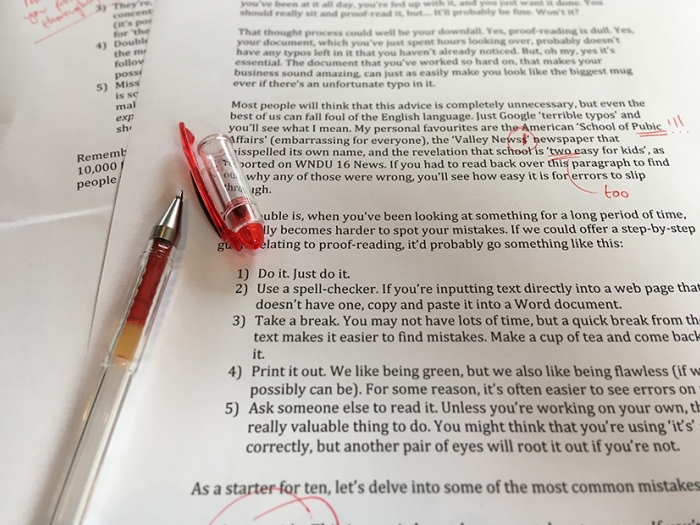Posted by Megan Oldcorn
We know how it is – you spend ages working on a document or a chunk of text, you’ve been at it all day, you’re fed up with it, and you just want it done. You should really sit and proof-read it, but… It’ll probably be fine. Won’t it?
That thought process could well be your downfall. Yes, proof-reading is dull. Yes, your document, which you’ve just spent hours looking over, probably doesn’t have any typos left in it that you haven’t already noticed. But, oh my, yes it’s essential. The document that you’ve worked so hard on, that makes your business sound amazing, can just as easily make you look like the biggest mug ever if there’s an unfortunate typo in it.
Most people will think that this advice is completely unnecessary, but even the best of us can fall foul of the English language. Just Google ‘terrible typos’ and you’ll see what I mean. My personal favourites are the American ‘School of Pubic Affairs’ (embarrassing for everyone), the ‘Valley Newss’ newspaper that misspelled its own name, and the revelation that school is ‘two easy for kids’, as reported on WNDU 16 News. If you had to read back over this paragraph to find out why any of those were wrong, you’ll see how easy it is for errors to slip through.
The trouble is, when you’ve been looking at something for a long period of time, it actually becomes harder to spot your mistakes. If we could offer a step-by-step guide relating to proof-reading, it’d probably go something like this:
- Do it. Just do it.
- Use a spell-checker. If you’re inputting text directly into a web page that doesn’t have one, copy and paste it into a Word document.
- Take a break. You may not have lots of time, but a quick break from the text makes it easier to find mistakes. Make a cup of tea and come back to it.
- Print it out. We like being green, but we also like being flawless (if we possibly can be). For some reason, it’s often easier to see errors on paper.
- Ask someone else to read it. Unless you’re working on your own, this is a really valuable thing to do. You might think that you’re using ‘it’s’ and ‘its’ correctly, but another pair of eyes will root it out if you’re not.
As a starter, let’s delve into some of the most common mistakes we see.
- Its v. it’s: This is a weird one that can catch out anyone. If you’re shortening ‘it is’ or ‘it has’, the result is it’s. If someone owns something (a possessive), you use its: e.g. ‘the dog chased after its ball’ or ‘Cornwall is known for its beaches.’
- Capitals v. lower case: Proper nouns (e.g. names) should always have a capital letter, whether it’s a person’s name, place name or a brand name, such as Coca Cola. However, if you’re referring to a thing more generally, like lemonade, it doesn’t.
- They’re, their and there: Even if you know this, a momentary lapse in concentration can catch you out. Their is when a group owns something (possessive), e.g. ‘the members pooled their resources’. They’re is short for ‘they are’ and there is a direction (e.g. over there).
- Double letters: words with a mix of single and double letters are among the most commonly misspelled. Do check a dictionary to be sure. The following are the correct spellings: accommodation, necessary, possession, disappoint, unforeseen.
- Missing words: it’s easy to miss words out of a sentence altogether, as this is something that a spell-checker won’t pick up on. To avoid it happening, make sure you read what is actually written on the page, not what you expect to be there. The same applies to words that can be accidentally shortened, like ‘off’ and ‘of’.
Remember, if in doubt, we can proof-read for you. If you’re paying out on having 10,000 flyers printed, you don’t want to end up in the same boat as the people who wrongly captioned Sesame Street’s the Count.

